Financial Reporting: Marks and Spencer Financial Statement Analysis
VerifiedAdded on 2021/01/01
|18
|5522
|498
Report
AI Summary
This report provides a comprehensive analysis of financial reporting, focusing on Marks and Spencer as a case study. It begins with an introduction to financial reporting, its context, and purpose, emphasizing the importance of accurate financial statements like the income statement and balance sheet for stakeholders. The report then delves into the regulatory and conceptual frameworks, including IFRS, and explains key principles and their significance. It identifies the main stakeholders of an organization and their benefits from financial information, covering shareholders, managers, investors, creditors, and customers. The report examines the value of financial reporting in meeting organizational growth and objectives, highlighting how transparent financial data can attract investors, satisfy customers, and maximize profits. It explores the preparation of financial statements, including the statement of profit and loss and the statement of financial position. The report also discusses the interpretation and communication of financial performance using financial statements, the difference between IAS and IFRS, and the benefits of IFRS. Finally, it assesses the varying degree of compliance with IFRS, providing a detailed overview of financial reporting practices and their implications for Marks and Spencer.
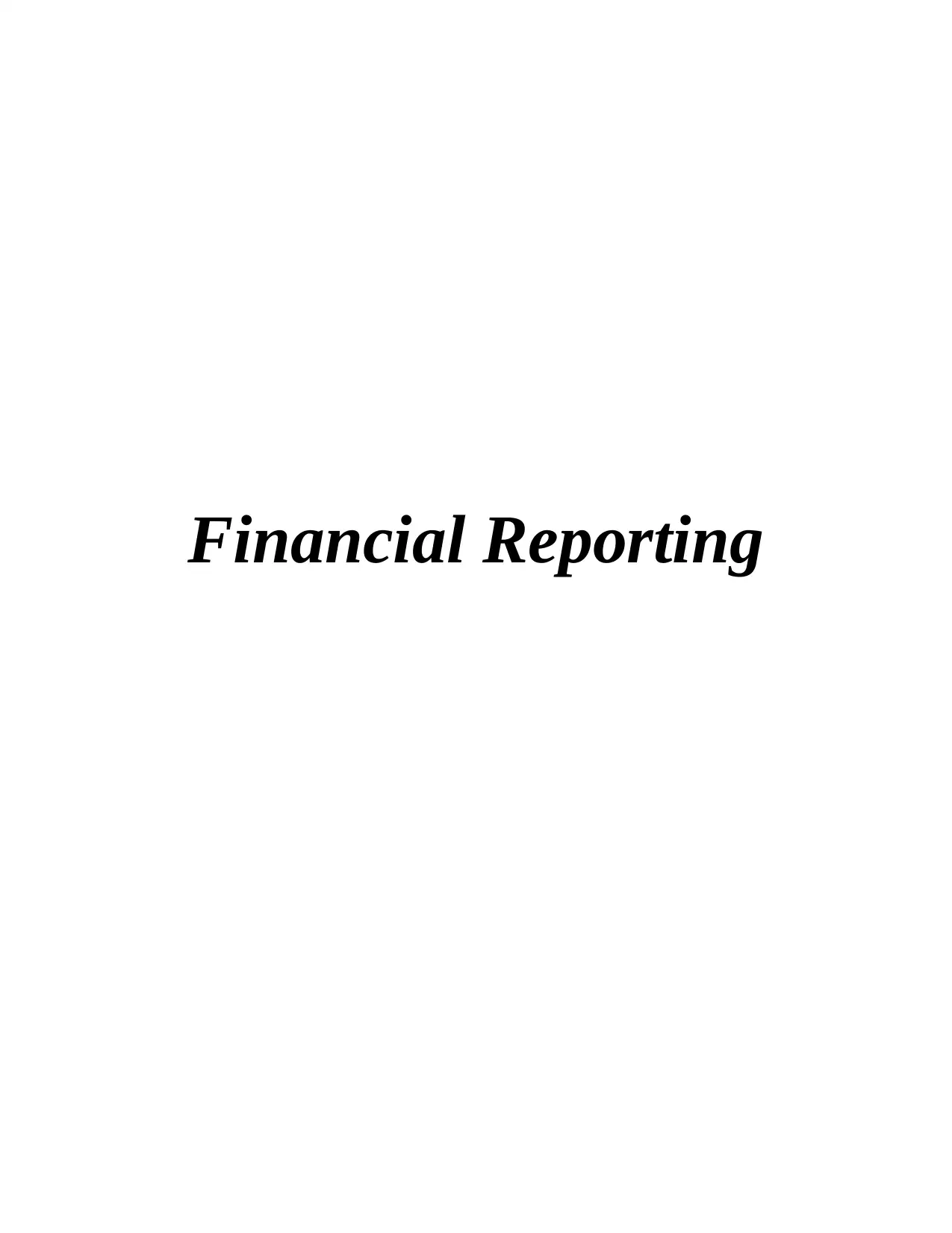
Financial Reporting
Paraphrase This Document
Need a fresh take? Get an instant paraphrase of this document with our AI Paraphraser
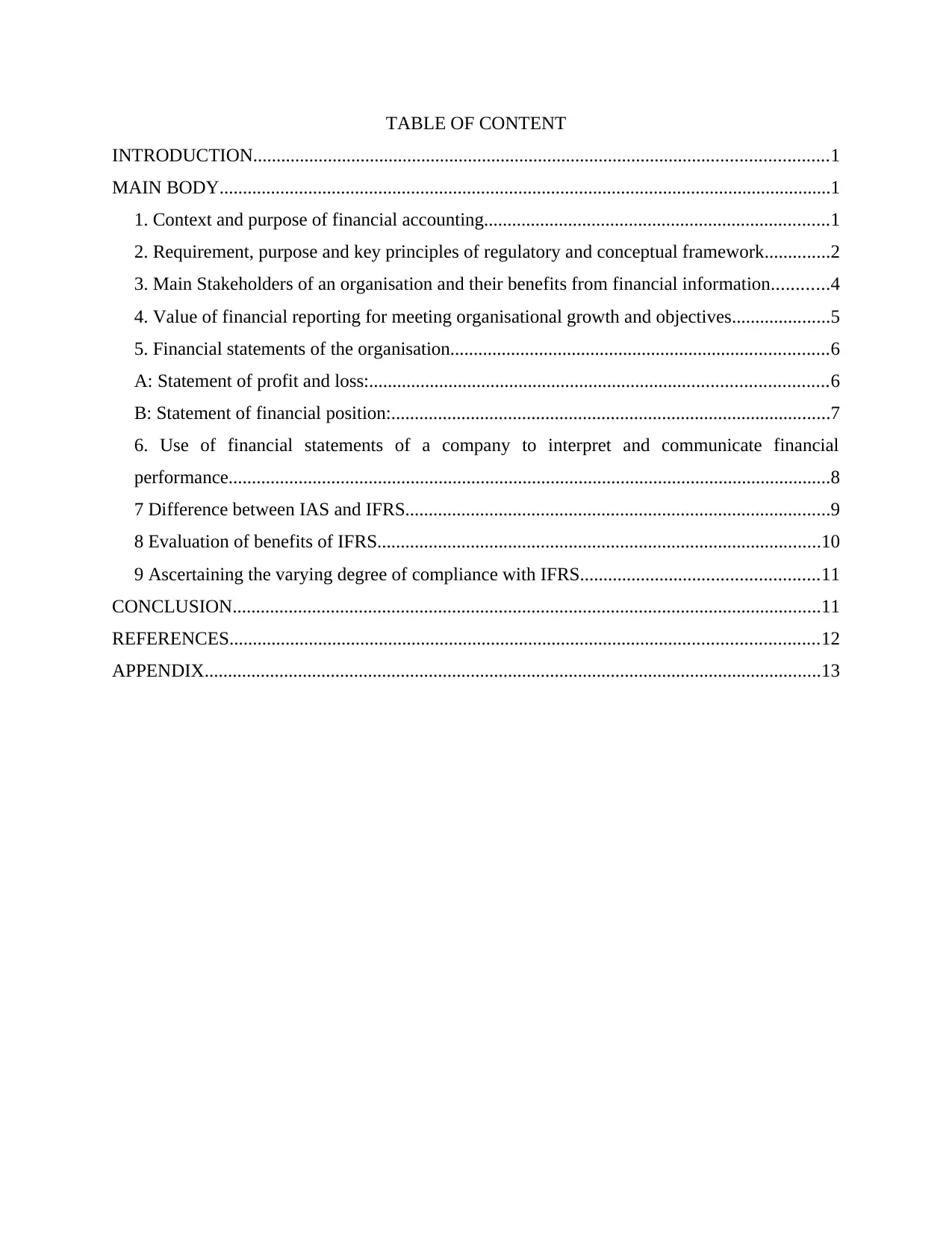
TABLE OF CONTENT
INTRODUCTION...........................................................................................................................1
MAIN BODY...................................................................................................................................1
1. Context and purpose of financial accounting..........................................................................1
2. Requirement, purpose and key principles of regulatory and conceptual framework..............2
3. Main Stakeholders of an organisation and their benefits from financial information............4
4. Value of financial reporting for meeting organisational growth and objectives.....................5
5. Financial statements of the organisation.................................................................................6
A: Statement of profit and loss:..................................................................................................6
B: Statement of financial position:..............................................................................................7
6. Use of financial statements of a company to interpret and communicate financial
performance.................................................................................................................................8
7 Difference between IAS and IFRS...........................................................................................9
8 Evaluation of benefits of IFRS...............................................................................................10
9 Ascertaining the varying degree of compliance with IFRS...................................................11
CONCLUSION..............................................................................................................................11
REFERENCES..............................................................................................................................12
APPENDIX....................................................................................................................................13
INTRODUCTION...........................................................................................................................1
MAIN BODY...................................................................................................................................1
1. Context and purpose of financial accounting..........................................................................1
2. Requirement, purpose and key principles of regulatory and conceptual framework..............2
3. Main Stakeholders of an organisation and their benefits from financial information............4
4. Value of financial reporting for meeting organisational growth and objectives.....................5
5. Financial statements of the organisation.................................................................................6
A: Statement of profit and loss:..................................................................................................6
B: Statement of financial position:..............................................................................................7
6. Use of financial statements of a company to interpret and communicate financial
performance.................................................................................................................................8
7 Difference between IAS and IFRS...........................................................................................9
8 Evaluation of benefits of IFRS...............................................................................................10
9 Ascertaining the varying degree of compliance with IFRS...................................................11
CONCLUSION..............................................................................................................................11
REFERENCES..............................................................................................................................12
APPENDIX....................................................................................................................................13
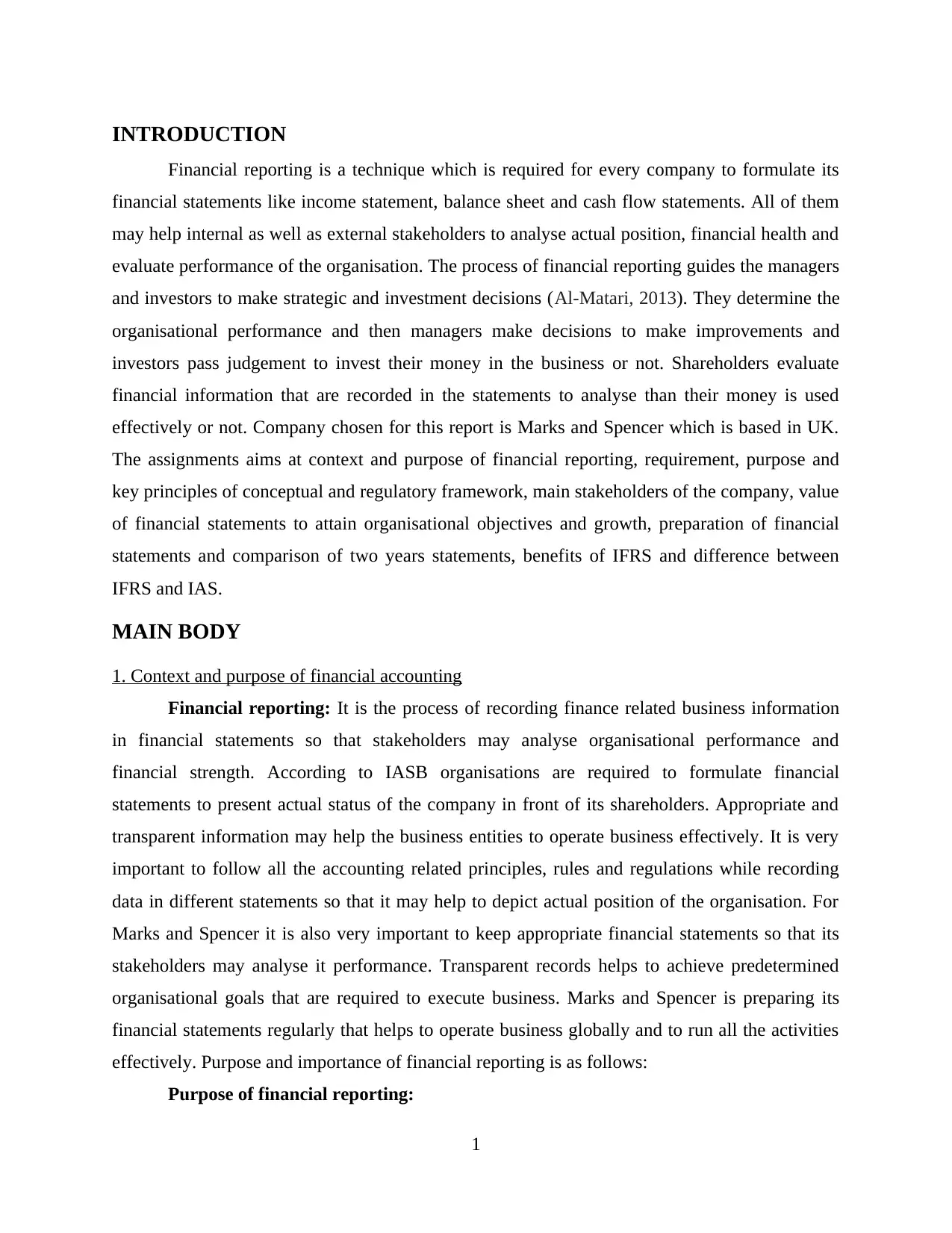
INTRODUCTION
Financial reporting is a technique which is required for every company to formulate its
financial statements like income statement, balance sheet and cash flow statements. All of them
may help internal as well as external stakeholders to analyse actual position, financial health and
evaluate performance of the organisation. The process of financial reporting guides the managers
and investors to make strategic and investment decisions (Al-Matari, 2013). They determine the
organisational performance and then managers make decisions to make improvements and
investors pass judgement to invest their money in the business or not. Shareholders evaluate
financial information that are recorded in the statements to analyse than their money is used
effectively or not. Company chosen for this report is Marks and Spencer which is based in UK.
The assignments aims at context and purpose of financial reporting, requirement, purpose and
key principles of conceptual and regulatory framework, main stakeholders of the company, value
of financial statements to attain organisational objectives and growth, preparation of financial
statements and comparison of two years statements, benefits of IFRS and difference between
IFRS and IAS.
MAIN BODY
1. Context and purpose of financial accounting
Financial reporting: It is the process of recording finance related business information
in financial statements so that stakeholders may analyse organisational performance and
financial strength. According to IASB organisations are required to formulate financial
statements to present actual status of the company in front of its shareholders. Appropriate and
transparent information may help the business entities to operate business effectively. It is very
important to follow all the accounting related principles, rules and regulations while recording
data in different statements so that it may help to depict actual position of the organisation. For
Marks and Spencer it is also very important to keep appropriate financial statements so that its
stakeholders may analyse it performance. Transparent records helps to achieve predetermined
organisational goals that are required to execute business. Marks and Spencer is preparing its
financial statements regularly that helps to operate business globally and to run all the activities
effectively. Purpose and importance of financial reporting is as follows:
Purpose of financial reporting:
1
Financial reporting is a technique which is required for every company to formulate its
financial statements like income statement, balance sheet and cash flow statements. All of them
may help internal as well as external stakeholders to analyse actual position, financial health and
evaluate performance of the organisation. The process of financial reporting guides the managers
and investors to make strategic and investment decisions (Al-Matari, 2013). They determine the
organisational performance and then managers make decisions to make improvements and
investors pass judgement to invest their money in the business or not. Shareholders evaluate
financial information that are recorded in the statements to analyse than their money is used
effectively or not. Company chosen for this report is Marks and Spencer which is based in UK.
The assignments aims at context and purpose of financial reporting, requirement, purpose and
key principles of conceptual and regulatory framework, main stakeholders of the company, value
of financial statements to attain organisational objectives and growth, preparation of financial
statements and comparison of two years statements, benefits of IFRS and difference between
IFRS and IAS.
MAIN BODY
1. Context and purpose of financial accounting
Financial reporting: It is the process of recording finance related business information
in financial statements so that stakeholders may analyse organisational performance and
financial strength. According to IASB organisations are required to formulate financial
statements to present actual status of the company in front of its shareholders. Appropriate and
transparent information may help the business entities to operate business effectively. It is very
important to follow all the accounting related principles, rules and regulations while recording
data in different statements so that it may help to depict actual position of the organisation. For
Marks and Spencer it is also very important to keep appropriate financial statements so that its
stakeholders may analyse it performance. Transparent records helps to achieve predetermined
organisational goals that are required to execute business. Marks and Spencer is preparing its
financial statements regularly that helps to operate business globally and to run all the activities
effectively. Purpose and importance of financial reporting is as follows:
Purpose of financial reporting:
1
⊘ This is a preview!⊘
Do you want full access?
Subscribe today to unlock all pages.

Trusted by 1+ million students worldwide
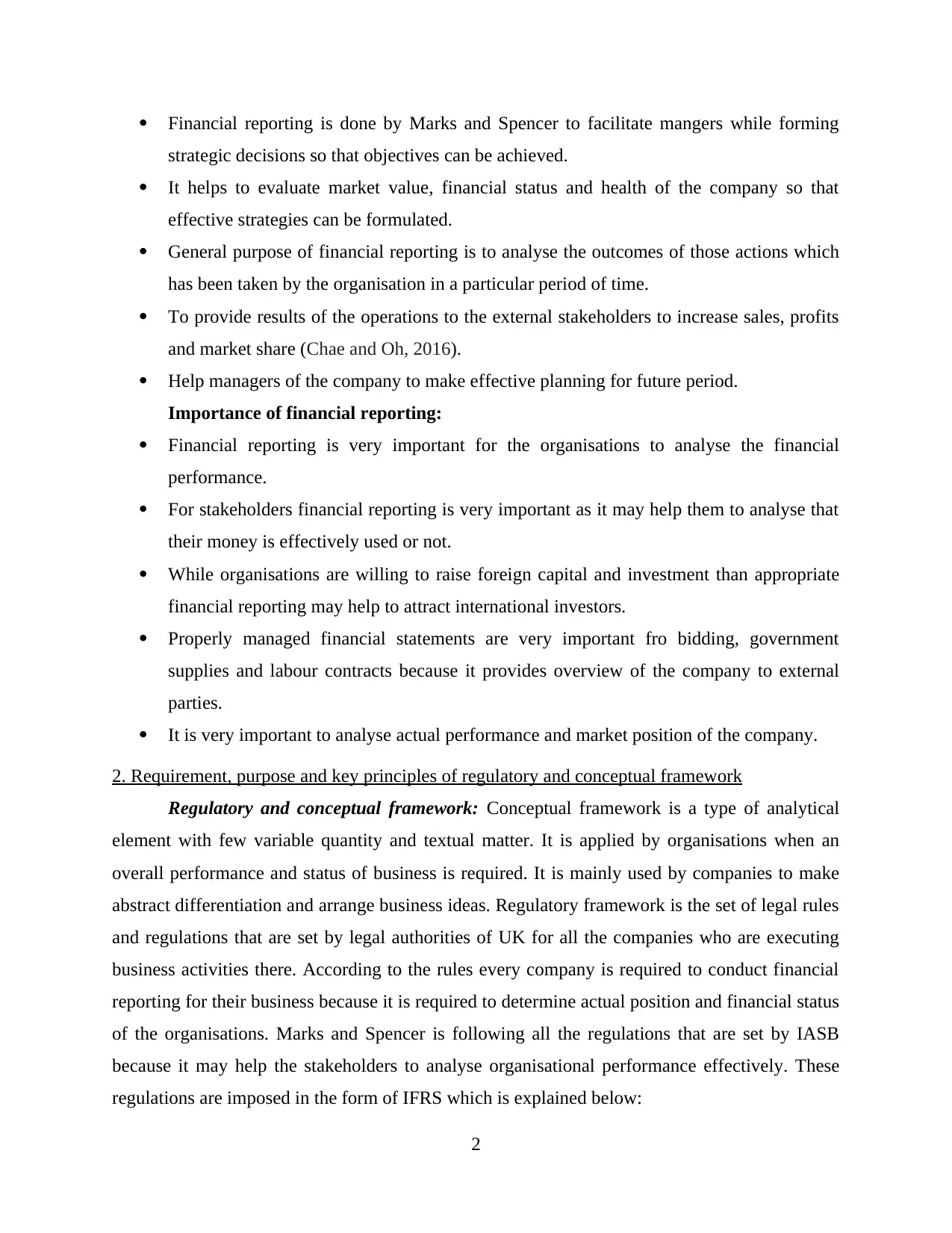
Financial reporting is done by Marks and Spencer to facilitate mangers while forming
strategic decisions so that objectives can be achieved.
It helps to evaluate market value, financial status and health of the company so that
effective strategies can be formulated.
General purpose of financial reporting is to analyse the outcomes of those actions which
has been taken by the organisation in a particular period of time.
To provide results of the operations to the external stakeholders to increase sales, profits
and market share (Chae and Oh, 2016).
Help managers of the company to make effective planning for future period.
Importance of financial reporting:
Financial reporting is very important for the organisations to analyse the financial
performance.
For stakeholders financial reporting is very important as it may help them to analyse that
their money is effectively used or not.
While organisations are willing to raise foreign capital and investment than appropriate
financial reporting may help to attract international investors.
Properly managed financial statements are very important fro bidding, government
supplies and labour contracts because it provides overview of the company to external
parties.
It is very important to analyse actual performance and market position of the company.
2. Requirement, purpose and key principles of regulatory and conceptual framework
Regulatory and conceptual framework: Conceptual framework is a type of analytical
element with few variable quantity and textual matter. It is applied by organisations when an
overall performance and status of business is required. It is mainly used by companies to make
abstract differentiation and arrange business ideas. Regulatory framework is the set of legal rules
and regulations that are set by legal authorities of UK for all the companies who are executing
business activities there. According to the rules every company is required to conduct financial
reporting for their business because it is required to determine actual position and financial status
of the organisations. Marks and Spencer is following all the regulations that are set by IASB
because it may help the stakeholders to analyse organisational performance effectively. These
regulations are imposed in the form of IFRS which is explained below:
2
strategic decisions so that objectives can be achieved.
It helps to evaluate market value, financial status and health of the company so that
effective strategies can be formulated.
General purpose of financial reporting is to analyse the outcomes of those actions which
has been taken by the organisation in a particular period of time.
To provide results of the operations to the external stakeholders to increase sales, profits
and market share (Chae and Oh, 2016).
Help managers of the company to make effective planning for future period.
Importance of financial reporting:
Financial reporting is very important for the organisations to analyse the financial
performance.
For stakeholders financial reporting is very important as it may help them to analyse that
their money is effectively used or not.
While organisations are willing to raise foreign capital and investment than appropriate
financial reporting may help to attract international investors.
Properly managed financial statements are very important fro bidding, government
supplies and labour contracts because it provides overview of the company to external
parties.
It is very important to analyse actual performance and market position of the company.
2. Requirement, purpose and key principles of regulatory and conceptual framework
Regulatory and conceptual framework: Conceptual framework is a type of analytical
element with few variable quantity and textual matter. It is applied by organisations when an
overall performance and status of business is required. It is mainly used by companies to make
abstract differentiation and arrange business ideas. Regulatory framework is the set of legal rules
and regulations that are set by legal authorities of UK for all the companies who are executing
business activities there. According to the rules every company is required to conduct financial
reporting for their business because it is required to determine actual position and financial status
of the organisations. Marks and Spencer is following all the regulations that are set by IASB
because it may help the stakeholders to analyse organisational performance effectively. These
regulations are imposed in the form of IFRS which is explained below:
2
Paraphrase This Document
Need a fresh take? Get an instant paraphrase of this document with our AI Paraphraser
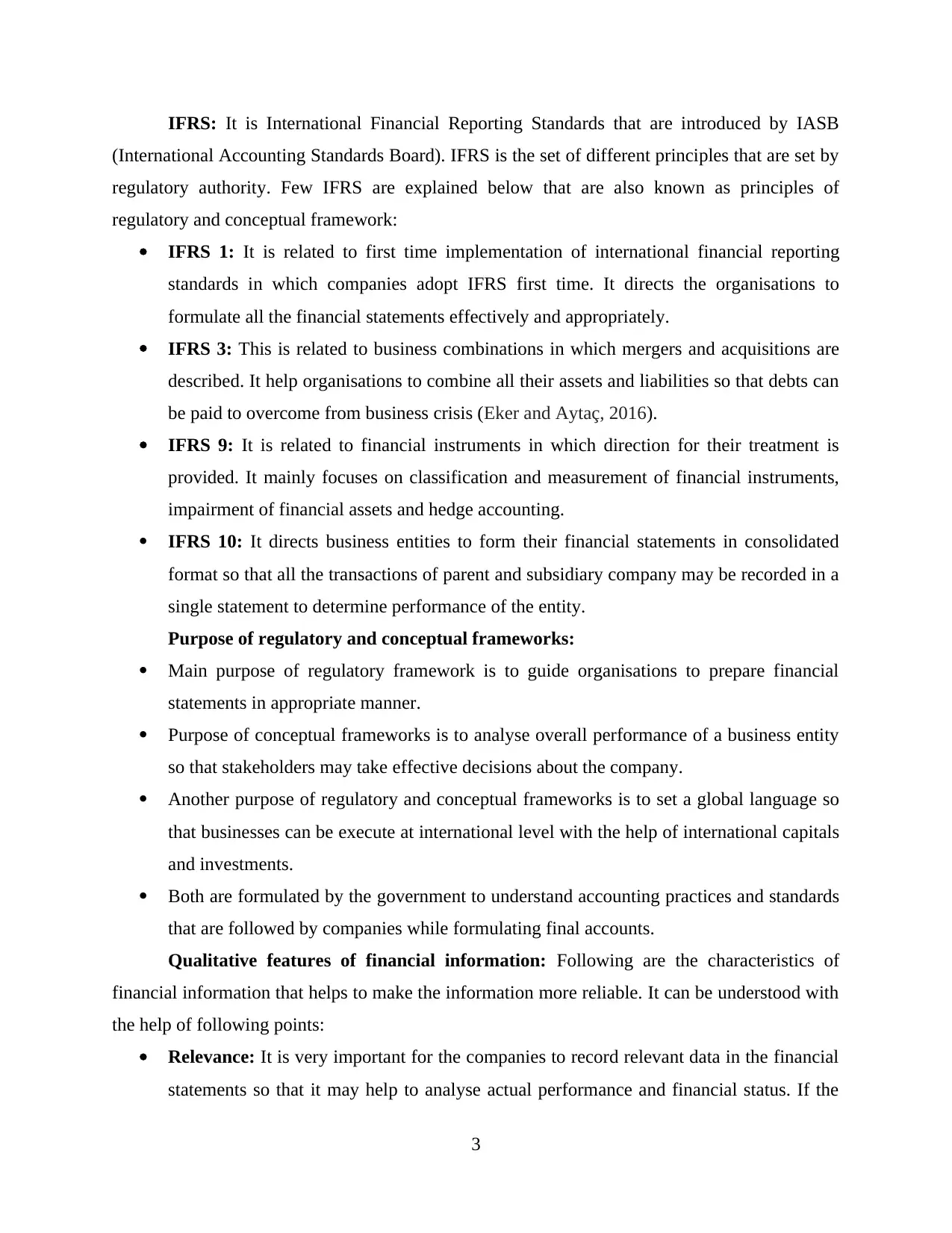
IFRS: It is International Financial Reporting Standards that are introduced by IASB
(International Accounting Standards Board). IFRS is the set of different principles that are set by
regulatory authority. Few IFRS are explained below that are also known as principles of
regulatory and conceptual framework:
IFRS 1: It is related to first time implementation of international financial reporting
standards in which companies adopt IFRS first time. It directs the organisations to
formulate all the financial statements effectively and appropriately.
IFRS 3: This is related to business combinations in which mergers and acquisitions are
described. It help organisations to combine all their assets and liabilities so that debts can
be paid to overcome from business crisis (Eker and Aytaç, 2016).
IFRS 9: It is related to financial instruments in which direction for their treatment is
provided. It mainly focuses on classification and measurement of financial instruments,
impairment of financial assets and hedge accounting.
IFRS 10: It directs business entities to form their financial statements in consolidated
format so that all the transactions of parent and subsidiary company may be recorded in a
single statement to determine performance of the entity.
Purpose of regulatory and conceptual frameworks:
Main purpose of regulatory framework is to guide organisations to prepare financial
statements in appropriate manner.
Purpose of conceptual frameworks is to analyse overall performance of a business entity
so that stakeholders may take effective decisions about the company.
Another purpose of regulatory and conceptual frameworks is to set a global language so
that businesses can be execute at international level with the help of international capitals
and investments.
Both are formulated by the government to understand accounting practices and standards
that are followed by companies while formulating final accounts.
Qualitative features of financial information: Following are the characteristics of
financial information that helps to make the information more reliable. It can be understood with
the help of following points:
Relevance: It is very important for the companies to record relevant data in the financial
statements so that it may help to analyse actual performance and financial status. If the
3
(International Accounting Standards Board). IFRS is the set of different principles that are set by
regulatory authority. Few IFRS are explained below that are also known as principles of
regulatory and conceptual framework:
IFRS 1: It is related to first time implementation of international financial reporting
standards in which companies adopt IFRS first time. It directs the organisations to
formulate all the financial statements effectively and appropriately.
IFRS 3: This is related to business combinations in which mergers and acquisitions are
described. It help organisations to combine all their assets and liabilities so that debts can
be paid to overcome from business crisis (Eker and Aytaç, 2016).
IFRS 9: It is related to financial instruments in which direction for their treatment is
provided. It mainly focuses on classification and measurement of financial instruments,
impairment of financial assets and hedge accounting.
IFRS 10: It directs business entities to form their financial statements in consolidated
format so that all the transactions of parent and subsidiary company may be recorded in a
single statement to determine performance of the entity.
Purpose of regulatory and conceptual frameworks:
Main purpose of regulatory framework is to guide organisations to prepare financial
statements in appropriate manner.
Purpose of conceptual frameworks is to analyse overall performance of a business entity
so that stakeholders may take effective decisions about the company.
Another purpose of regulatory and conceptual frameworks is to set a global language so
that businesses can be execute at international level with the help of international capitals
and investments.
Both are formulated by the government to understand accounting practices and standards
that are followed by companies while formulating final accounts.
Qualitative features of financial information: Following are the characteristics of
financial information that helps to make the information more reliable. It can be understood with
the help of following points:
Relevance: It is very important for the companies to record relevant data in the financial
statements so that it may help to analyse actual performance and financial status. If the
3
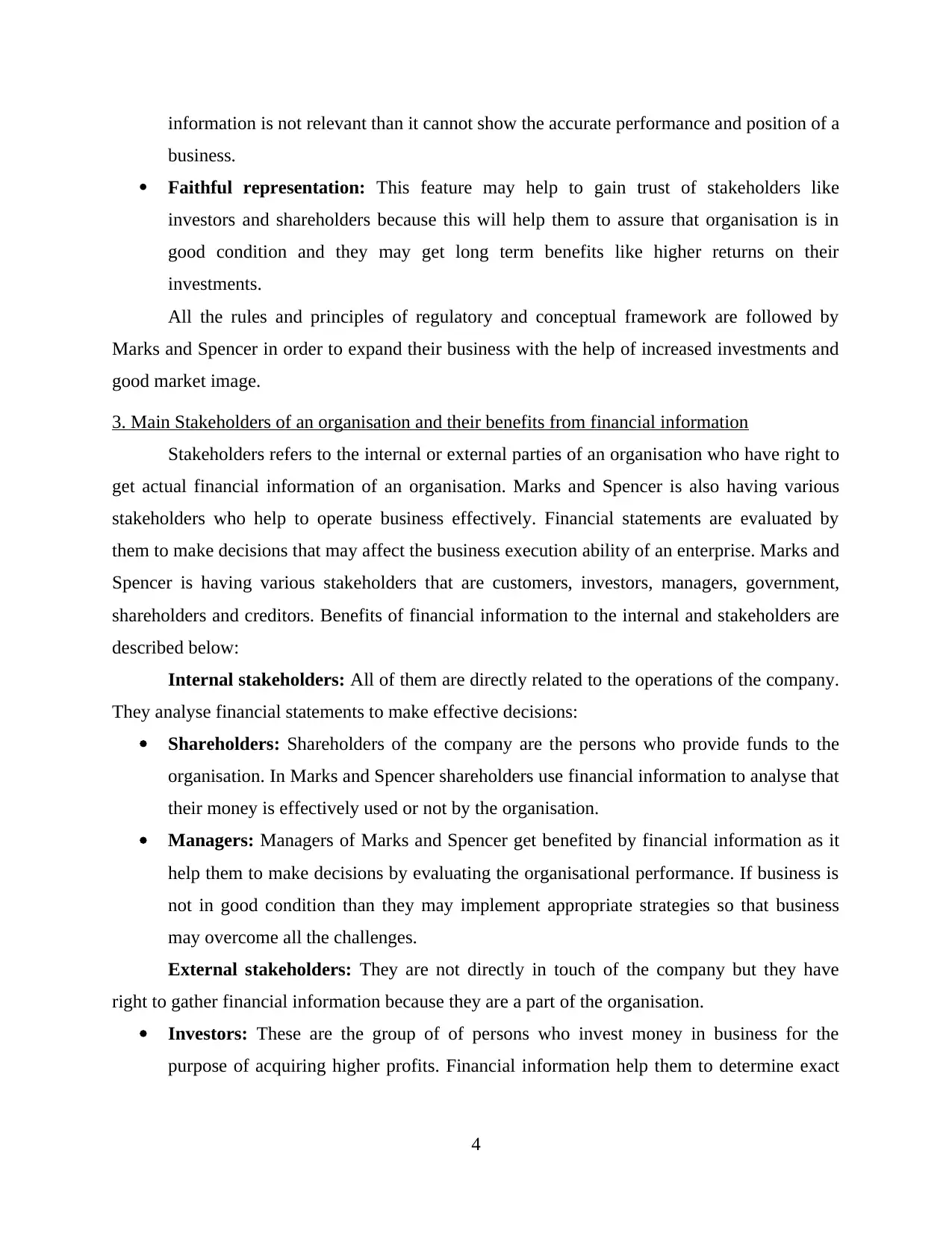
information is not relevant than it cannot show the accurate performance and position of a
business.
Faithful representation: This feature may help to gain trust of stakeholders like
investors and shareholders because this will help them to assure that organisation is in
good condition and they may get long term benefits like higher returns on their
investments.
All the rules and principles of regulatory and conceptual framework are followed by
Marks and Spencer in order to expand their business with the help of increased investments and
good market image.
3. Main Stakeholders of an organisation and their benefits from financial information
Stakeholders refers to the internal or external parties of an organisation who have right to
get actual financial information of an organisation. Marks and Spencer is also having various
stakeholders who help to operate business effectively. Financial statements are evaluated by
them to make decisions that may affect the business execution ability of an enterprise. Marks and
Spencer is having various stakeholders that are customers, investors, managers, government,
shareholders and creditors. Benefits of financial information to the internal and stakeholders are
described below:
Internal stakeholders: All of them are directly related to the operations of the company.
They analyse financial statements to make effective decisions:
Shareholders: Shareholders of the company are the persons who provide funds to the
organisation. In Marks and Spencer shareholders use financial information to analyse that
their money is effectively used or not by the organisation.
Managers: Managers of Marks and Spencer get benefited by financial information as it
help them to make decisions by evaluating the organisational performance. If business is
not in good condition than they may implement appropriate strategies so that business
may overcome all the challenges.
External stakeholders: They are not directly in touch of the company but they have
right to gather financial information because they are a part of the organisation.
Investors: These are the group of of persons who invest money in business for the
purpose of acquiring higher profits. Financial information help them to determine exact
4
business.
Faithful representation: This feature may help to gain trust of stakeholders like
investors and shareholders because this will help them to assure that organisation is in
good condition and they may get long term benefits like higher returns on their
investments.
All the rules and principles of regulatory and conceptual framework are followed by
Marks and Spencer in order to expand their business with the help of increased investments and
good market image.
3. Main Stakeholders of an organisation and their benefits from financial information
Stakeholders refers to the internal or external parties of an organisation who have right to
get actual financial information of an organisation. Marks and Spencer is also having various
stakeholders who help to operate business effectively. Financial statements are evaluated by
them to make decisions that may affect the business execution ability of an enterprise. Marks and
Spencer is having various stakeholders that are customers, investors, managers, government,
shareholders and creditors. Benefits of financial information to the internal and stakeholders are
described below:
Internal stakeholders: All of them are directly related to the operations of the company.
They analyse financial statements to make effective decisions:
Shareholders: Shareholders of the company are the persons who provide funds to the
organisation. In Marks and Spencer shareholders use financial information to analyse that
their money is effectively used or not by the organisation.
Managers: Managers of Marks and Spencer get benefited by financial information as it
help them to make decisions by evaluating the organisational performance. If business is
not in good condition than they may implement appropriate strategies so that business
may overcome all the challenges.
External stakeholders: They are not directly in touch of the company but they have
right to gather financial information because they are a part of the organisation.
Investors: These are the group of of persons who invest money in business for the
purpose of acquiring higher profits. Financial information help them to determine exact
4
⊘ This is a preview!⊘
Do you want full access?
Subscribe today to unlock all pages.

Trusted by 1+ million students worldwide
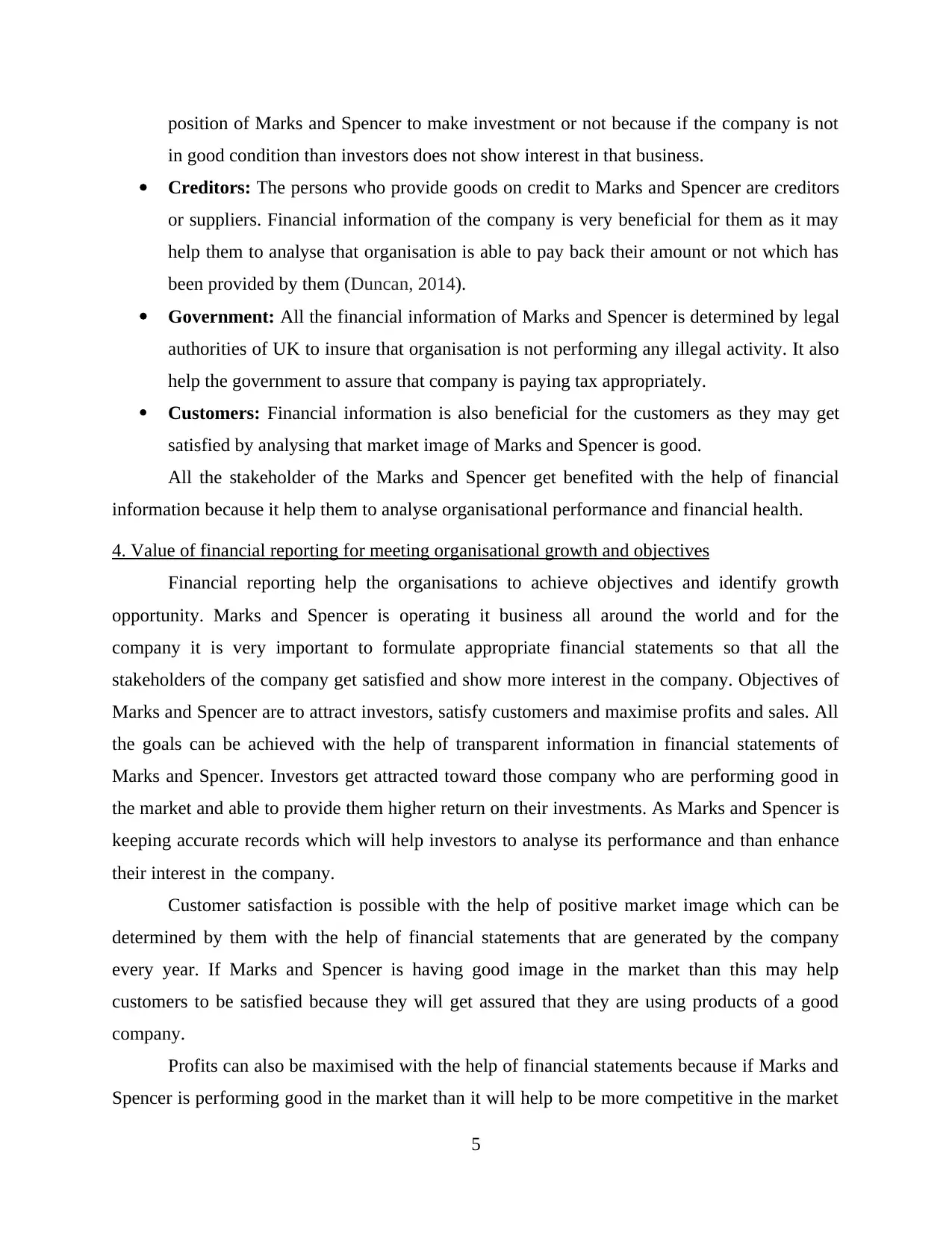
position of Marks and Spencer to make investment or not because if the company is not
in good condition than investors does not show interest in that business.
Creditors: The persons who provide goods on credit to Marks and Spencer are creditors
or suppliers. Financial information of the company is very beneficial for them as it may
help them to analyse that organisation is able to pay back their amount or not which has
been provided by them (Duncan, 2014).
Government: All the financial information of Marks and Spencer is determined by legal
authorities of UK to insure that organisation is not performing any illegal activity. It also
help the government to assure that company is paying tax appropriately.
Customers: Financial information is also beneficial for the customers as they may get
satisfied by analysing that market image of Marks and Spencer is good.
All the stakeholder of the Marks and Spencer get benefited with the help of financial
information because it help them to analyse organisational performance and financial health.
4. Value of financial reporting for meeting organisational growth and objectives
Financial reporting help the organisations to achieve objectives and identify growth
opportunity. Marks and Spencer is operating it business all around the world and for the
company it is very important to formulate appropriate financial statements so that all the
stakeholders of the company get satisfied and show more interest in the company. Objectives of
Marks and Spencer are to attract investors, satisfy customers and maximise profits and sales. All
the goals can be achieved with the help of transparent information in financial statements of
Marks and Spencer. Investors get attracted toward those company who are performing good in
the market and able to provide them higher return on their investments. As Marks and Spencer is
keeping accurate records which will help investors to analyse its performance and than enhance
their interest in the company.
Customer satisfaction is possible with the help of positive market image which can be
determined by them with the help of financial statements that are generated by the company
every year. If Marks and Spencer is having good image in the market than this may help
customers to be satisfied because they will get assured that they are using products of a good
company.
Profits can also be maximised with the help of financial statements because if Marks and
Spencer is performing good in the market than it will help to be more competitive in the market
5
in good condition than investors does not show interest in that business.
Creditors: The persons who provide goods on credit to Marks and Spencer are creditors
or suppliers. Financial information of the company is very beneficial for them as it may
help them to analyse that organisation is able to pay back their amount or not which has
been provided by them (Duncan, 2014).
Government: All the financial information of Marks and Spencer is determined by legal
authorities of UK to insure that organisation is not performing any illegal activity. It also
help the government to assure that company is paying tax appropriately.
Customers: Financial information is also beneficial for the customers as they may get
satisfied by analysing that market image of Marks and Spencer is good.
All the stakeholder of the Marks and Spencer get benefited with the help of financial
information because it help them to analyse organisational performance and financial health.
4. Value of financial reporting for meeting organisational growth and objectives
Financial reporting help the organisations to achieve objectives and identify growth
opportunity. Marks and Spencer is operating it business all around the world and for the
company it is very important to formulate appropriate financial statements so that all the
stakeholders of the company get satisfied and show more interest in the company. Objectives of
Marks and Spencer are to attract investors, satisfy customers and maximise profits and sales. All
the goals can be achieved with the help of transparent information in financial statements of
Marks and Spencer. Investors get attracted toward those company who are performing good in
the market and able to provide them higher return on their investments. As Marks and Spencer is
keeping accurate records which will help investors to analyse its performance and than enhance
their interest in the company.
Customer satisfaction is possible with the help of positive market image which can be
determined by them with the help of financial statements that are generated by the company
every year. If Marks and Spencer is having good image in the market than this may help
customers to be satisfied because they will get assured that they are using products of a good
company.
Profits can also be maximised with the help of financial statements because if Marks and
Spencer is performing good in the market than it will help to be more competitive in the market
5
Paraphrase This Document
Need a fresh take? Get an instant paraphrase of this document with our AI Paraphraser
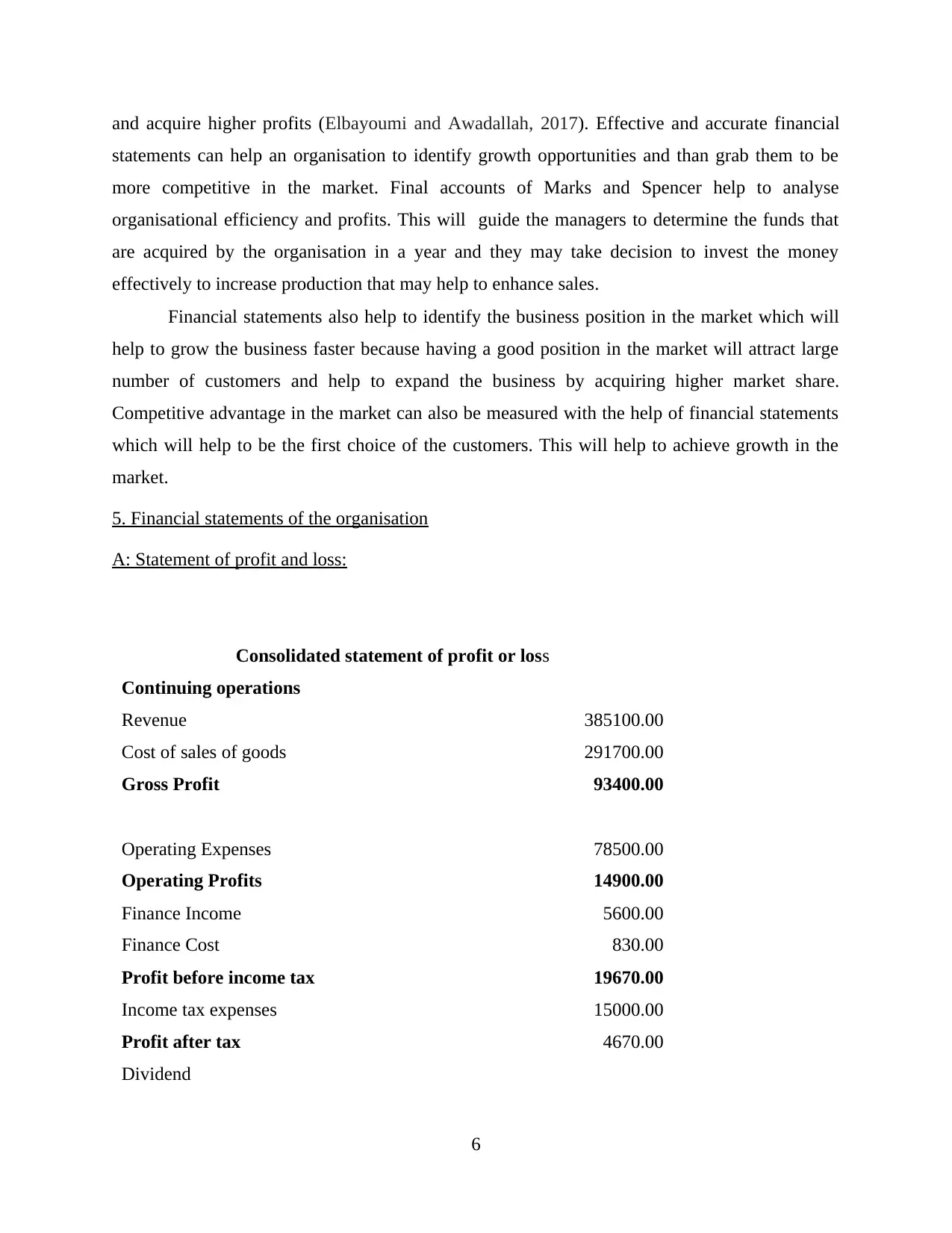
and acquire higher profits (Elbayoumi and Awadallah, 2017). Effective and accurate financial
statements can help an organisation to identify growth opportunities and than grab them to be
more competitive in the market. Final accounts of Marks and Spencer help to analyse
organisational efficiency and profits. This will guide the managers to determine the funds that
are acquired by the organisation in a year and they may take decision to invest the money
effectively to increase production that may help to enhance sales.
Financial statements also help to identify the business position in the market which will
help to grow the business faster because having a good position in the market will attract large
number of customers and help to expand the business by acquiring higher market share.
Competitive advantage in the market can also be measured with the help of financial statements
which will help to be the first choice of the customers. This will help to achieve growth in the
market.
5. Financial statements of the organisation
A: Statement of profit and loss:
Consolidated statement of profit or loss
Continuing operations
Revenue 385100.00
Cost of sales of goods 291700.00
Gross Profit 93400.00
Operating Expenses 78500.00
Operating Profits 14900.00
Finance Income 5600.00
Finance Cost 830.00
Profit before income tax 19670.00
Income tax expenses 15000.00
Profit after tax 4670.00
Dividend
6
statements can help an organisation to identify growth opportunities and than grab them to be
more competitive in the market. Final accounts of Marks and Spencer help to analyse
organisational efficiency and profits. This will guide the managers to determine the funds that
are acquired by the organisation in a year and they may take decision to invest the money
effectively to increase production that may help to enhance sales.
Financial statements also help to identify the business position in the market which will
help to grow the business faster because having a good position in the market will attract large
number of customers and help to expand the business by acquiring higher market share.
Competitive advantage in the market can also be measured with the help of financial statements
which will help to be the first choice of the customers. This will help to achieve growth in the
market.
5. Financial statements of the organisation
A: Statement of profit and loss:
Consolidated statement of profit or loss
Continuing operations
Revenue 385100.00
Cost of sales of goods 291700.00
Gross Profit 93400.00
Operating Expenses 78500.00
Operating Profits 14900.00
Finance Income 5600.00
Finance Cost 830.00
Profit before income tax 19670.00
Income tax expenses 15000.00
Profit after tax 4670.00
Dividend
6
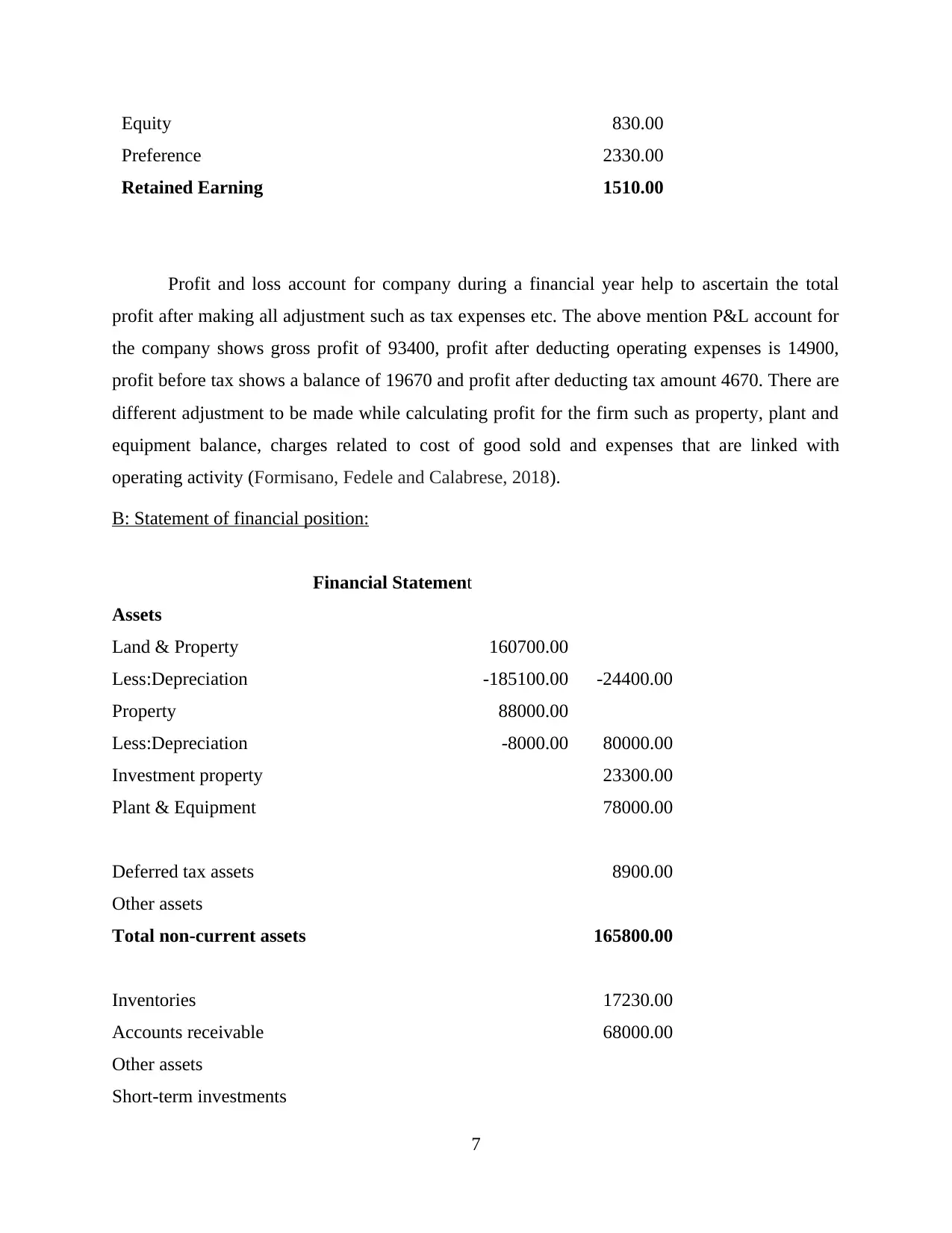
Equity 830.00
Preference 2330.00
Retained Earning 1510.00
Profit and loss account for company during a financial year help to ascertain the total
profit after making all adjustment such as tax expenses etc. The above mention P&L account for
the company shows gross profit of 93400, profit after deducting operating expenses is 14900,
profit before tax shows a balance of 19670 and profit after deducting tax amount 4670. There are
different adjustment to be made while calculating profit for the firm such as property, plant and
equipment balance, charges related to cost of good sold and expenses that are linked with
operating activity (Formisano, Fedele and Calabrese, 2018).
B: Statement of financial position:
Financial Statement
Assets
Land & Property 160700.00
Less:Depreciation -185100.00 -24400.00
Property 88000.00
Less:Depreciation -8000.00 80000.00
Investment property 23300.00
Plant & Equipment 78000.00
Deferred tax assets 8900.00
Other assets
Total non-current assets 165800.00
Inventories 17230.00
Accounts receivable 68000.00
Other assets
Short-term investments
7
Preference 2330.00
Retained Earning 1510.00
Profit and loss account for company during a financial year help to ascertain the total
profit after making all adjustment such as tax expenses etc. The above mention P&L account for
the company shows gross profit of 93400, profit after deducting operating expenses is 14900,
profit before tax shows a balance of 19670 and profit after deducting tax amount 4670. There are
different adjustment to be made while calculating profit for the firm such as property, plant and
equipment balance, charges related to cost of good sold and expenses that are linked with
operating activity (Formisano, Fedele and Calabrese, 2018).
B: Statement of financial position:
Financial Statement
Assets
Land & Property 160700.00
Less:Depreciation -185100.00 -24400.00
Property 88000.00
Less:Depreciation -8000.00 80000.00
Investment property 23300.00
Plant & Equipment 78000.00
Deferred tax assets 8900.00
Other assets
Total non-current assets 165800.00
Inventories 17230.00
Accounts receivable 68000.00
Other assets
Short-term investments
7
⊘ This is a preview!⊘
Do you want full access?
Subscribe today to unlock all pages.

Trusted by 1+ million students worldwide
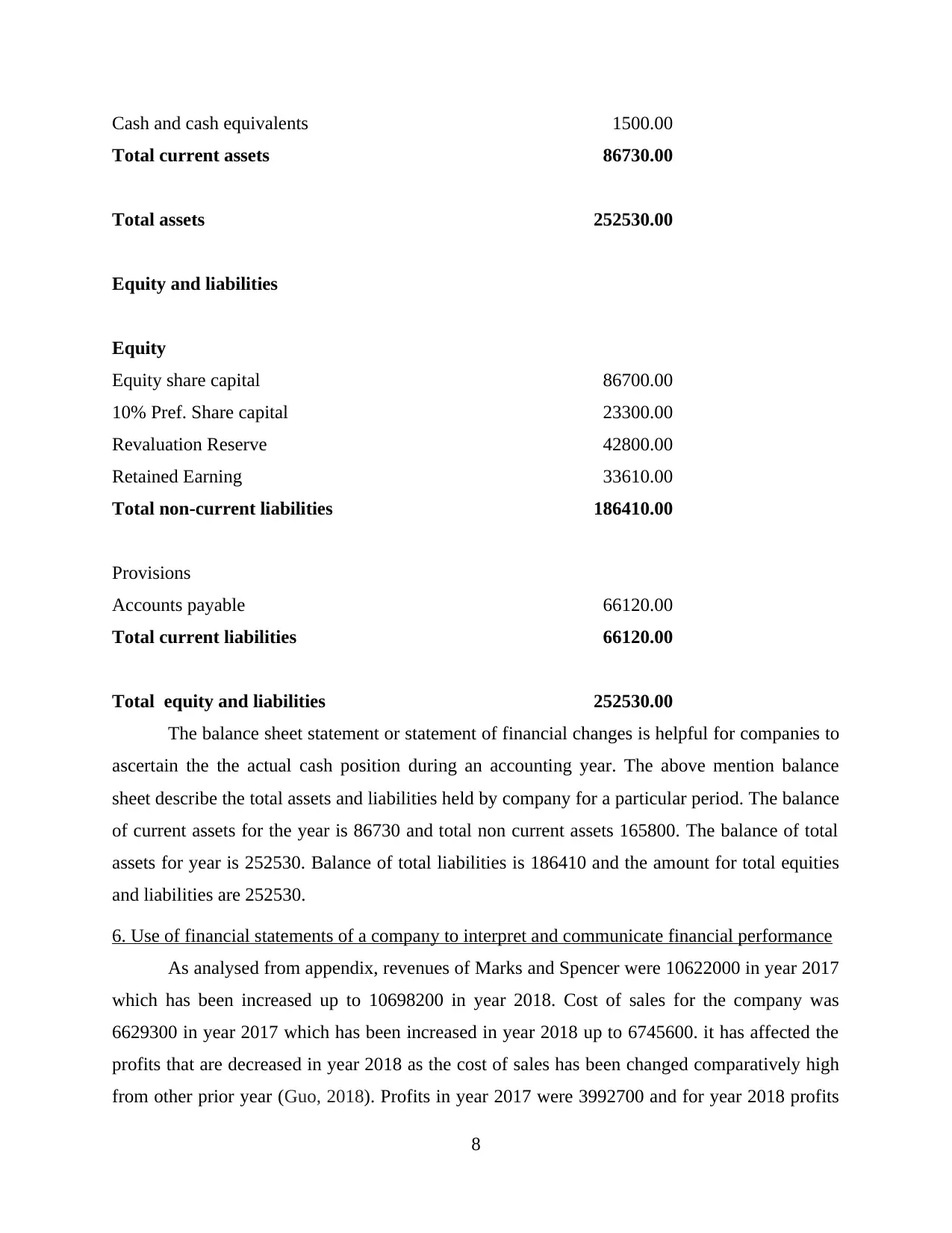
Cash and cash equivalents 1500.00
Total current assets 86730.00
Total assets 252530.00
Equity and liabilities
Equity
Equity share capital 86700.00
10% Pref. Share capital 23300.00
Revaluation Reserve 42800.00
Retained Earning 33610.00
Total non-current liabilities 186410.00
Provisions
Accounts payable 66120.00
Total current liabilities 66120.00
Total equity and liabilities 252530.00
The balance sheet statement or statement of financial changes is helpful for companies to
ascertain the the actual cash position during an accounting year. The above mention balance
sheet describe the total assets and liabilities held by company for a particular period. The balance
of current assets for the year is 86730 and total non current assets 165800. The balance of total
assets for year is 252530. Balance of total liabilities is 186410 and the amount for total equities
and liabilities are 252530.
6. Use of financial statements of a company to interpret and communicate financial performance
As analysed from appendix, revenues of Marks and Spencer were 10622000 in year 2017
which has been increased up to 10698200 in year 2018. Cost of sales for the company was
6629300 in year 2017 which has been increased in year 2018 up to 6745600. it has affected the
profits that are decreased in year 2018 as the cost of sales has been changed comparatively high
from other prior year (Guo, 2018). Profits in year 2017 were 3992700 and for year 2018 profits
8
Total current assets 86730.00
Total assets 252530.00
Equity and liabilities
Equity
Equity share capital 86700.00
10% Pref. Share capital 23300.00
Revaluation Reserve 42800.00
Retained Earning 33610.00
Total non-current liabilities 186410.00
Provisions
Accounts payable 66120.00
Total current liabilities 66120.00
Total equity and liabilities 252530.00
The balance sheet statement or statement of financial changes is helpful for companies to
ascertain the the actual cash position during an accounting year. The above mention balance
sheet describe the total assets and liabilities held by company for a particular period. The balance
of current assets for the year is 86730 and total non current assets 165800. The balance of total
assets for year is 252530. Balance of total liabilities is 186410 and the amount for total equities
and liabilities are 252530.
6. Use of financial statements of a company to interpret and communicate financial performance
As analysed from appendix, revenues of Marks and Spencer were 10622000 in year 2017
which has been increased up to 10698200 in year 2018. Cost of sales for the company was
6629300 in year 2017 which has been increased in year 2018 up to 6745600. it has affected the
profits that are decreased in year 2018 as the cost of sales has been changed comparatively high
from other prior year (Guo, 2018). Profits in year 2017 were 3992700 and for year 2018 profits
8
Paraphrase This Document
Need a fresh take? Get an instant paraphrase of this document with our AI Paraphraser
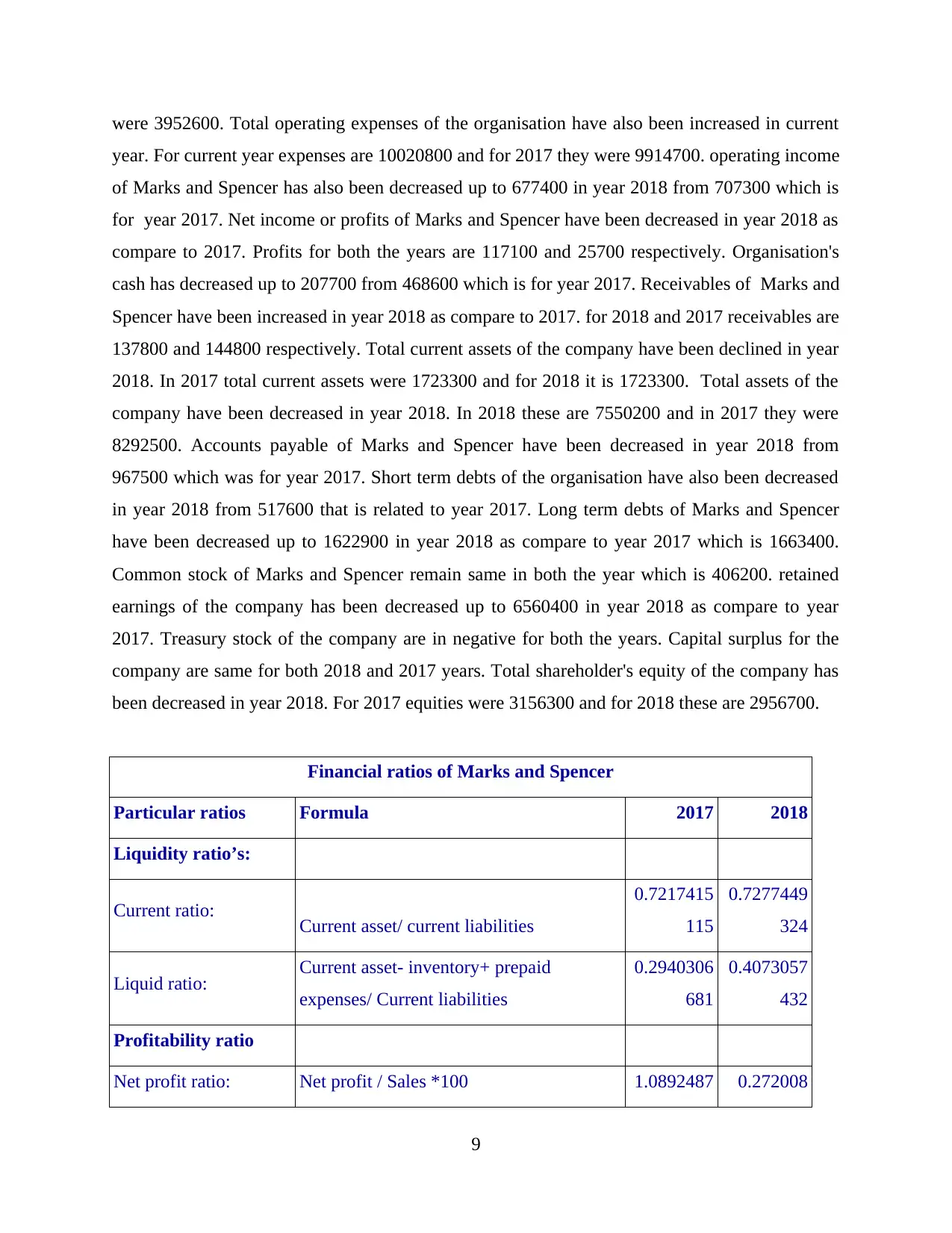
were 3952600. Total operating expenses of the organisation have also been increased in current
year. For current year expenses are 10020800 and for 2017 they were 9914700. operating income
of Marks and Spencer has also been decreased up to 677400 in year 2018 from 707300 which is
for year 2017. Net income or profits of Marks and Spencer have been decreased in year 2018 as
compare to 2017. Profits for both the years are 117100 and 25700 respectively. Organisation's
cash has decreased up to 207700 from 468600 which is for year 2017. Receivables of Marks and
Spencer have been increased in year 2018 as compare to 2017. for 2018 and 2017 receivables are
137800 and 144800 respectively. Total current assets of the company have been declined in year
2018. In 2017 total current assets were 1723300 and for 2018 it is 1723300. Total assets of the
company have been decreased in year 2018. In 2018 these are 7550200 and in 2017 they were
8292500. Accounts payable of Marks and Spencer have been decreased in year 2018 from
967500 which was for year 2017. Short term debts of the organisation have also been decreased
in year 2018 from 517600 that is related to year 2017. Long term debts of Marks and Spencer
have been decreased up to 1622900 in year 2018 as compare to year 2017 which is 1663400.
Common stock of Marks and Spencer remain same in both the year which is 406200. retained
earnings of the company has been decreased up to 6560400 in year 2018 as compare to year
2017. Treasury stock of the company are in negative for both the years. Capital surplus for the
company are same for both 2018 and 2017 years. Total shareholder's equity of the company has
been decreased in year 2018. For 2017 equities were 3156300 and for 2018 these are 2956700.
Financial ratios of Marks and Spencer
Particular ratios Formula 2017 2018
Liquidity ratio’s:
Current ratio: Current asset/ current liabilities
0.7217415
115
0.7277449
324
Liquid ratio: Current asset- inventory+ prepaid
expenses/ Current liabilities
0.2940306
681
0.4073057
432
Profitability ratio
Net profit ratio: Net profit / Sales *100 1.0892487 0.272008
9
year. For current year expenses are 10020800 and for 2017 they were 9914700. operating income
of Marks and Spencer has also been decreased up to 677400 in year 2018 from 707300 which is
for year 2017. Net income or profits of Marks and Spencer have been decreased in year 2018 as
compare to 2017. Profits for both the years are 117100 and 25700 respectively. Organisation's
cash has decreased up to 207700 from 468600 which is for year 2017. Receivables of Marks and
Spencer have been increased in year 2018 as compare to 2017. for 2018 and 2017 receivables are
137800 and 144800 respectively. Total current assets of the company have been declined in year
2018. In 2017 total current assets were 1723300 and for 2018 it is 1723300. Total assets of the
company have been decreased in year 2018. In 2018 these are 7550200 and in 2017 they were
8292500. Accounts payable of Marks and Spencer have been decreased in year 2018 from
967500 which was for year 2017. Short term debts of the organisation have also been decreased
in year 2018 from 517600 that is related to year 2017. Long term debts of Marks and Spencer
have been decreased up to 1622900 in year 2018 as compare to year 2017 which is 1663400.
Common stock of Marks and Spencer remain same in both the year which is 406200. retained
earnings of the company has been decreased up to 6560400 in year 2018 as compare to year
2017. Treasury stock of the company are in negative for both the years. Capital surplus for the
company are same for both 2018 and 2017 years. Total shareholder's equity of the company has
been decreased in year 2018. For 2017 equities were 3156300 and for 2018 these are 2956700.
Financial ratios of Marks and Spencer
Particular ratios Formula 2017 2018
Liquidity ratio’s:
Current ratio: Current asset/ current liabilities
0.7217415
115
0.7277449
324
Liquid ratio: Current asset- inventory+ prepaid
expenses/ Current liabilities
0.2940306
681
0.4073057
432
Profitability ratio
Net profit ratio: Net profit / Sales *100 1.0892487 0.272008
9
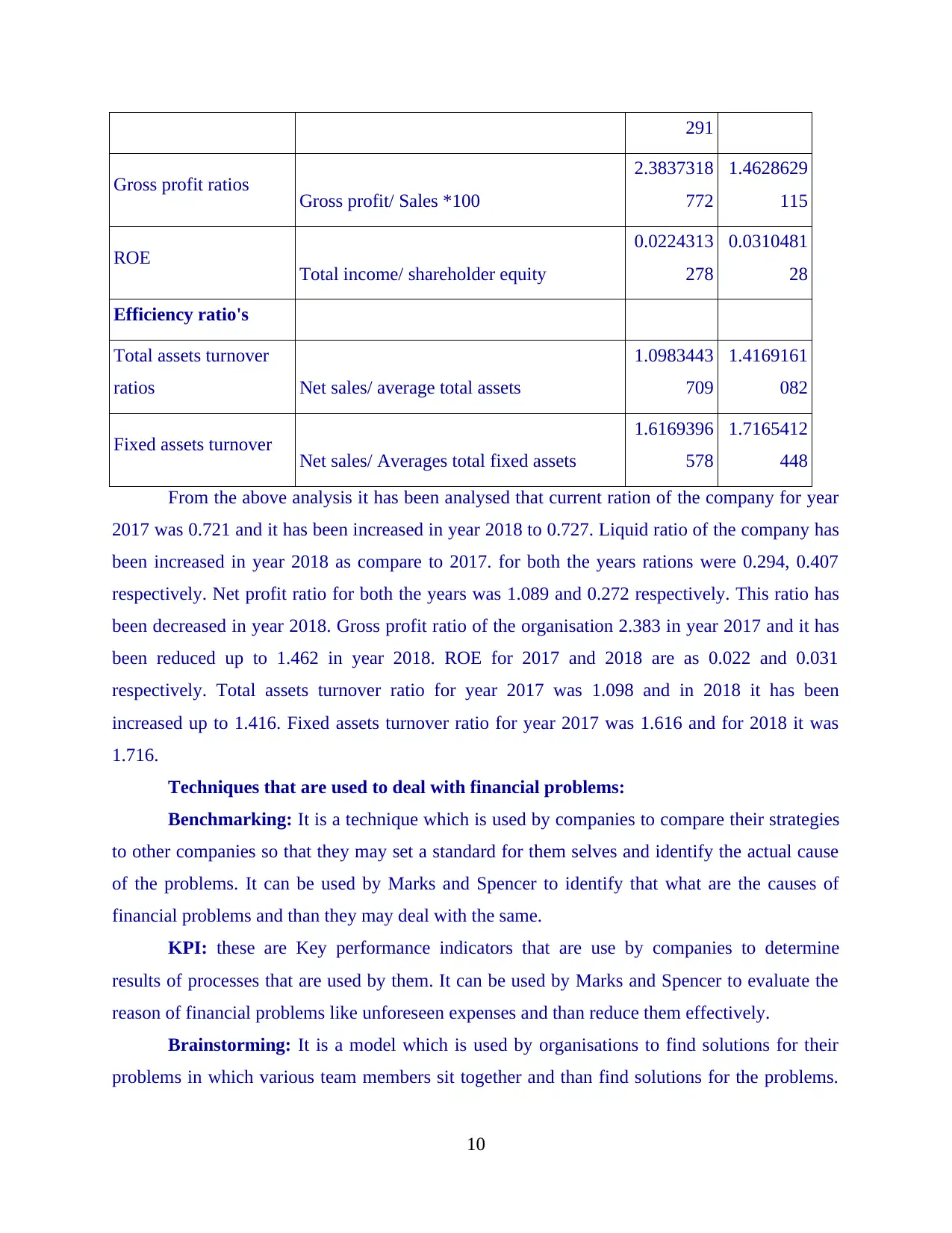
291
Gross profit ratios Gross profit/ Sales *100
2.3837318
772
1.4628629
115
ROE Total income/ shareholder equity
0.0224313
278
0.0310481
28
Efficiency ratio's
Total assets turnover
ratios Net sales/ average total assets
1.0983443
709
1.4169161
082
Fixed assets turnover Net sales/ Averages total fixed assets
1.6169396
578
1.7165412
448
From the above analysis it has been analysed that current ration of the company for year
2017 was 0.721 and it has been increased in year 2018 to 0.727. Liquid ratio of the company has
been increased in year 2018 as compare to 2017. for both the years rations were 0.294, 0.407
respectively. Net profit ratio for both the years was 1.089 and 0.272 respectively. This ratio has
been decreased in year 2018. Gross profit ratio of the organisation 2.383 in year 2017 and it has
been reduced up to 1.462 in year 2018. ROE for 2017 and 2018 are as 0.022 and 0.031
respectively. Total assets turnover ratio for year 2017 was 1.098 and in 2018 it has been
increased up to 1.416. Fixed assets turnover ratio for year 2017 was 1.616 and for 2018 it was
1.716.
Techniques that are used to deal with financial problems:
Benchmarking: It is a technique which is used by companies to compare their strategies
to other companies so that they may set a standard for them selves and identify the actual cause
of the problems. It can be used by Marks and Spencer to identify that what are the causes of
financial problems and than they may deal with the same.
KPI: these are Key performance indicators that are use by companies to determine
results of processes that are used by them. It can be used by Marks and Spencer to evaluate the
reason of financial problems like unforeseen expenses and than reduce them effectively.
Brainstorming: It is a model which is used by organisations to find solutions for their
problems in which various team members sit together and than find solutions for the problems.
10
Gross profit ratios Gross profit/ Sales *100
2.3837318
772
1.4628629
115
ROE Total income/ shareholder equity
0.0224313
278
0.0310481
28
Efficiency ratio's
Total assets turnover
ratios Net sales/ average total assets
1.0983443
709
1.4169161
082
Fixed assets turnover Net sales/ Averages total fixed assets
1.6169396
578
1.7165412
448
From the above analysis it has been analysed that current ration of the company for year
2017 was 0.721 and it has been increased in year 2018 to 0.727. Liquid ratio of the company has
been increased in year 2018 as compare to 2017. for both the years rations were 0.294, 0.407
respectively. Net profit ratio for both the years was 1.089 and 0.272 respectively. This ratio has
been decreased in year 2018. Gross profit ratio of the organisation 2.383 in year 2017 and it has
been reduced up to 1.462 in year 2018. ROE for 2017 and 2018 are as 0.022 and 0.031
respectively. Total assets turnover ratio for year 2017 was 1.098 and in 2018 it has been
increased up to 1.416. Fixed assets turnover ratio for year 2017 was 1.616 and for 2018 it was
1.716.
Techniques that are used to deal with financial problems:
Benchmarking: It is a technique which is used by companies to compare their strategies
to other companies so that they may set a standard for them selves and identify the actual cause
of the problems. It can be used by Marks and Spencer to identify that what are the causes of
financial problems and than they may deal with the same.
KPI: these are Key performance indicators that are use by companies to determine
results of processes that are used by them. It can be used by Marks and Spencer to evaluate the
reason of financial problems like unforeseen expenses and than reduce them effectively.
Brainstorming: It is a model which is used by organisations to find solutions for their
problems in which various team members sit together and than find solutions for the problems.
10
⊘ This is a preview!⊘
Do you want full access?
Subscribe today to unlock all pages.

Trusted by 1+ million students worldwide
1 out of 18
Related Documents
Your All-in-One AI-Powered Toolkit for Academic Success.
+13062052269
info@desklib.com
Available 24*7 on WhatsApp / Email
![[object Object]](/_next/static/media/star-bottom.7253800d.svg)
Unlock your academic potential
Copyright © 2020–2025 A2Z Services. All Rights Reserved. Developed and managed by ZUCOL.





